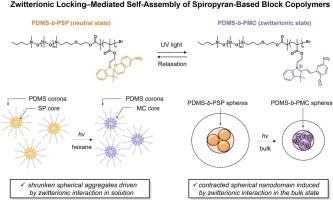Zwitterionic locking of spiropyran-based block copolymer self-assembly
IF 6.3
2区 化学
Q1 POLYMER SCIENCE
引用次数: 0
Abstract
This study explores the role of zwitterionic interactions in the self-assembly behavior of block copolymers containing polydimethylsiloxane (PDMS) and spiropyran (SP) in response to reversible UV-induced isomerization from SP to merocyanine (MC). This alters the polarity and rigidity of the self-assembled copolymer, modulating intermolecular interactions among the copolymer blocks. The self-assembly behavior of SP- and MC-containing block copolymers was investigated in both solution and bulk states, highlighting interactions among zwitterionic MC units. Notably, the relaxation kinetics of MC-to-SP ring closure were highly sensitive to the medium, as confirmed via UV–vis spectroscopy. Structural reorganization following photoisomerization was characterized via dynamic light scattering, atomic force microscopy, and small-angle X-ray scattering, revealing changes in polymer aggregate size and domain spacing, attributable to strong zwitterionic interactions in both solution and bulk. These findings demonstrate the role of photoinduced zwitterionic interactions in block copolymer self-assembly and provide insights into the design of photoresponsive polymeric materials.

螺旋吡喃基嵌段共聚物自组装的两性离子锁定
本研究探讨了两性离子相互作用在含聚二甲基硅氧烷(PDMS)和螺吡喃(SP)嵌段共聚物自组装行为中的作用,以响应从SP到merocyanine (MC)的可逆紫外诱导异构化。这改变了自组装共聚物的极性和刚性,调节共聚物嵌段之间的分子间相互作用。研究了SP-和MC-嵌段共聚物在溶液和体态下的自组装行为,重点研究了两性离子MC单元之间的相互作用。值得注意的是,通过紫外可见光谱证实,mc - sp环闭合的弛豫动力学对介质高度敏感。通过动态光散射、原子力显微镜和小角度x射线散射表征了光异构化后的结构重组,揭示了聚合物聚集体尺寸和畴间距的变化,这可归因于溶液和体中强烈的两性离子相互作用。这些发现证明了光诱导两性离子相互作用在嵌段共聚物自组装中的作用,并为光响应聚合物材料的设计提供了见解。
本文章由计算机程序翻译,如有差异,请以英文原文为准。
求助全文
约1分钟内获得全文
求助全文
来源期刊

European Polymer Journal
化学-高分子科学
CiteScore
9.90
自引率
10.00%
发文量
691
审稿时长
23 days
期刊介绍:
European Polymer Journal is dedicated to publishing work on fundamental and applied polymer chemistry and macromolecular materials. The journal covers all aspects of polymer synthesis, including polymerization mechanisms and chemical functional transformations, with a focus on novel polymers and the relationships between molecular structure and polymer properties. In addition, we welcome submissions on bio-based or renewable polymers, stimuli-responsive systems and polymer bio-hybrids. European Polymer Journal also publishes research on the biomedical application of polymers, including drug delivery and regenerative medicine. The main scope is covered but not limited to the following core research areas:
Polymer synthesis and functionalization
• Novel synthetic routes for polymerization, functional modification, controlled/living polymerization and precision polymers.
Stimuli-responsive polymers
• Including shape memory and self-healing polymers.
Supramolecular polymers and self-assembly
• Molecular recognition and higher order polymer structures.
Renewable and sustainable polymers
• Bio-based, biodegradable and anti-microbial polymers and polymeric bio-nanocomposites.
Polymers at interfaces and surfaces
• Chemistry and engineering of surfaces with biological relevance, including patterning, antifouling polymers and polymers for membrane applications.
Biomedical applications and nanomedicine
• Polymers for regenerative medicine, drug delivery molecular release and gene therapy
The scope of European Polymer Journal no longer includes Polymer Physics.
 求助内容:
求助内容: 应助结果提醒方式:
应助结果提醒方式:


